Instructions for Side by Side Printing
- Print the notecards
- Fold each page in half along the solid vertical line
- Cut out the notecards by cutting along each horizontal dotted line
- Optional: Glue, tape or staple the ends of each notecard together
Cf 4
front 1 1) The element present in all organic molecules is
Answer: Topic: Concept 4.1 Skill: Knowledge/Comprehension | back 1 C |
front 2 2) The complexity and variety of organic molecules is due to
Answer: Topic: Concept 4.1 Skill: Knowledge/Comprehension | back 2 A |
front 3 3) The experimental approach taken in current biological investigations presumes that
Answer: Topic: Concept 4.1 Skill: Knowledge/Comprehension | back 3 E |
front 4 4) Differences among organisms are caused by
Answer: Topic: Concept 4.1 Skill: Application/Analysis | back 4 B |
front 5 5) Which of the following people was the first to synthesize an organic compound, urea, from inorganic starting materials?
Answer: Topic: Concept 4.1 Skill: Knowledge/Comprehension | back 5 C |
front 6 6) Stanley Miller's 1953 experiments proved that
Answer: Topic: Concept 4.1 Skill: Synthesis/Evaluation | back 6 B |
front 7 7) Hermann Kolbe's synthesis of an organic compound, acetic acid, from inorganic substances that had been prepared directly from pure elements was a significant milestone for what reason?
Answer: Topic: Concept 4.1 Skill: Synthesis/Evaluation | back 7 E |
front 8 8) Stanley Miller's 1953 experiments assumed that early Earth's atmosphere contained
Answer: Topic: Concept 4.1 Skill: Knowledge/Comprehension | back 8 B |
front 9 9) When Stanley Miller applied heat and electrical sparks to a mixture of simple inorganic compounds such as methane, hydrogen gas, ammonia, and water vapor, what compounds were produced?
Answer: Topic: Concept 4.1 Skill: Knowledge/Comprehension | back 9 E |
front 10 10) How many electron pairs does carbon share in order to complete its valence shell?
Answer: Topic: Concept 4.2 Skill: Knowledge/Comprehension | back 10 D |
front 11 11) A carbon atom is most likely to form what kind of bond(s) with other atoms?
Answer: Topic: Concept 4.2 Skill: Knowledge/Comprehension | back 11 C |
front 12 12) Which of the following statements best describes the carbon atoms present in a seed-eating bird?
Answer: Topic: Concept 4.2 Skill: Synthesis/Evaluation | back 12 E |
front 13 13) Which of the following statements best describes the carbon atoms present in a seed-eating bird?
Answer: Topic: Concept 4.2 Skill: Synthesis/Evaluation | back 13 D |
front 14 14) Why are hydrocarbons insoluble in water?
Answer: Topic: Concept 4.2 Skill: Knowledge/Comprehension | back 14 B |
front 15 15) How many structural isomers are possible for a substance having the molecular formula C4H10?
Answer: Topic: Concept 4.2 Skill: Application/Analysis | back 15 B |
front 16 16) Which of the following statements correctly describes cis-trans isomers?
Answer: Topic: Concept 4.2 Skill: Knowledge/Comprehension | back 16 A |
front 17 17) Research indicates that ibuprofen, a drug used to relieve inflammation and pain, is a mixture of two enantiomers; that is, molecules that
Answer: Topic: Concept 4.2 Skill: Knowledge/Comprehension | back 17 B |
front 18 18) What determines whether a carbon atom's covalent bonds to other atoms are in a tetrahedral configuration or a planar configuration?
Answer: Topic: Concept 4.2 Skill: Application/Analysis | back 18 B |
front 19 19) Compared to a hydrocarbon chain where all the carbon atoms are linked by single bonds, a hydrocarbon chain with the same number of carbon atoms, but with one or more double bonds, will
Answer: Topic: Concept 4.2 Skill: Application/Analysis | back 19 B |
front 20 20) Organic molecules with only hydrogens and five carbon atoms can have different structures in all of the following ways except
Answer: Topic: Concept 4.2 Skill: Application/Analysis | back 20 E |
front 21 21) A compound contains hydroxyl groups as its predominant functional group. Which of the following statements is true concerning this compound?
Answer: Topic: Concept 4.3 Skill: Knowledge/Comprehension | back 21 B |
front 22 22) Which of the following is a false statement concerning amino groups?
Answer: Topic: Concept 4.3 Skill: Knowledge/Comprehension | back 22 D |
front 23 23) Which two functional groups are always found in amino acids?
Answer: Topic: Concept 4.3 Skill: Knowledge/Comprehension | back 23 C |
front 24 24) Amino acids are acids because they always possess which functional group?
Answer: Topic: Concept 4.3 Skill: Knowledge/Comprehension | back 24 C |
front 25 25) A carbon skeleton is covalently bonded to both an amino group and a carboxyl group. When placed in water it
Answer: Topic: Concept 4.3 Skill: Application/Analysis | back 25 D |
front 26 26) Which functional groups can act as acids?
Answer: Topic: Concept 4.3 Skill: Knowledge/Comprehension | back 26 C |
front 27 27) Testosterone and estradiol are
Answer: Topic: Concept 4.3 Skill: Application/Analysis | back 27 B |
front 28 28) Testosterone and estradiol are male and female sex hormones, respectively, in many vertebrates. In what way(s) do these molecules differ from each other?
Answer: Topic: Concept 4.3 Skill: Knowledge/Comprehension | back 28 C |
front 29 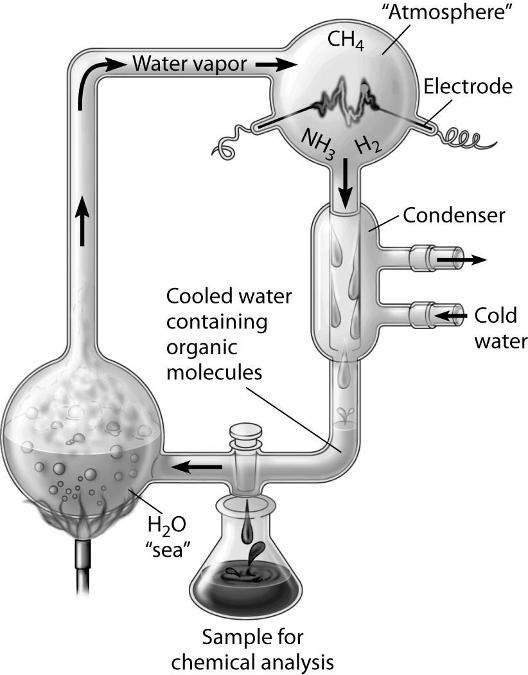 29) Which of the following people used this apparatus to study the formation of organic compounds?
Answer: Topic: Concept 4.1 Skill: Knowledge/Comprehension | back 29 A |
front 30 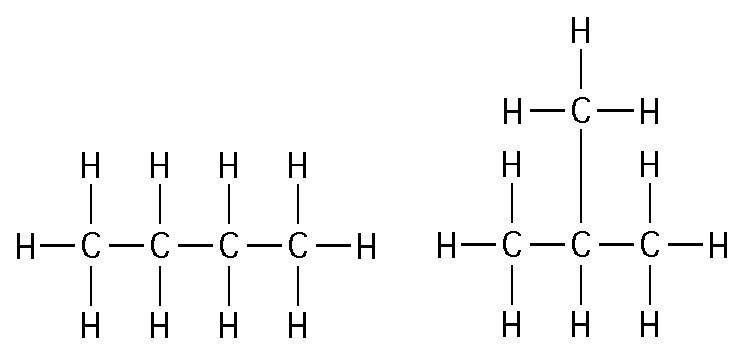 30) The two molecules shown in the figure above are best described as
Answer: Topic: Concept 4.2 Skill: Knowledge/Comprehension | back 30 C |
front 31 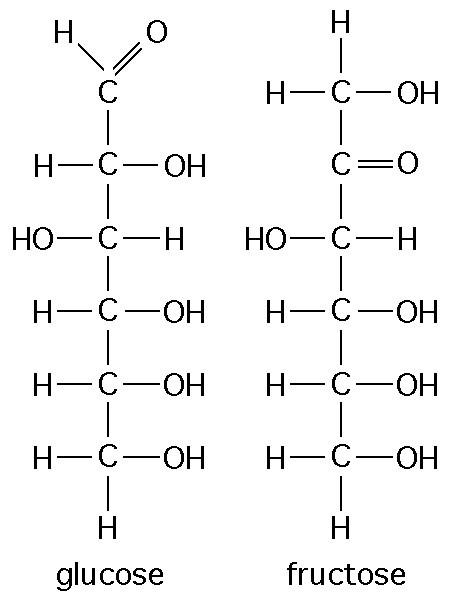 31) The figure above shows the structures of glucose and fructose. These two molecules differ in the
Answer: Topic: Concept 4.2 Skill: Knowledge/Comprehension | back 31 C |
front 32 32) The figure above shows the structures of glucose and fructose. These two molecules are
Answer: Topic: Concept 4.2 Skill: Knowledge/Comprehension | back 32 D |
front 33 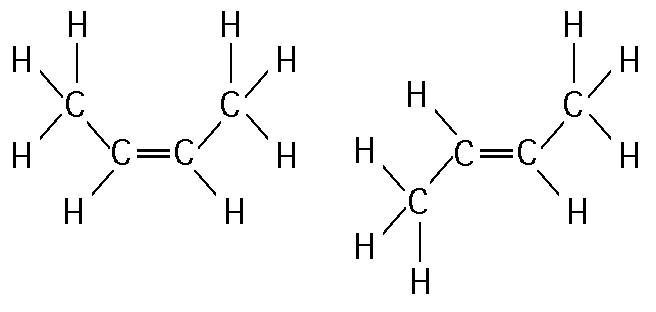 33) The two molecules shown in the figure above are best described as
Answer: Topic: Concept 4.2 Skill: Knowledge/Comprehension | back 33 E |
front 34 34) Three or four of the following illustrations depict different structural isomers of the organic compound with molecular formula C6H14. For clarity, only the carbon skeletons are shown; hydrogen atoms that would be attached to the carbons have been omitted. Which one, if any, is NOT a structural isomer of this compound | back 34 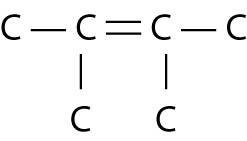 C |
front 35 35) Which of the pairs of molecular structures shown below depict enantiomers (enantiomeric forms) of the same molecule? | back 35 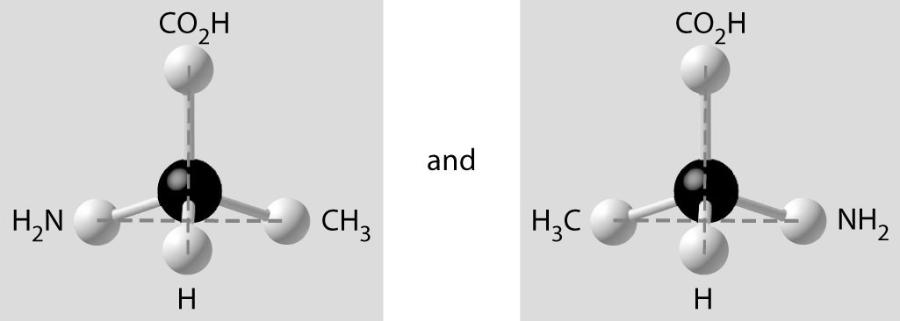 D |
front 36 36) Which of the pairs of molecular structures shown below do NOT depict enantiomers (enantiomeric forms) of the same molecule? | back 36  C |
front 37 37) Which pair of molecules shown below are not enantiomers of a single molecule? | back 37 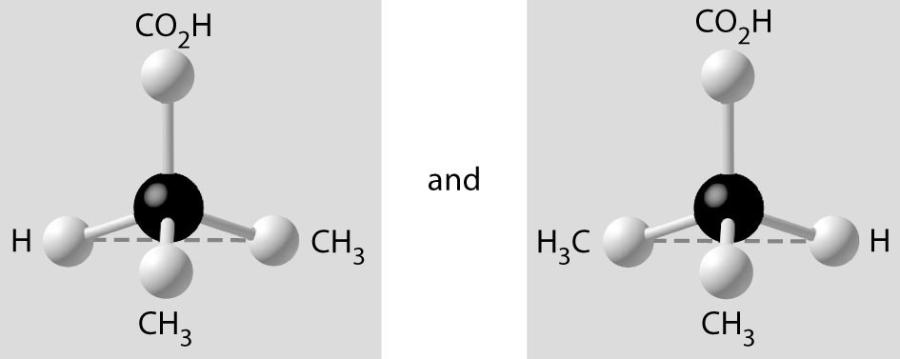 B |
front 38 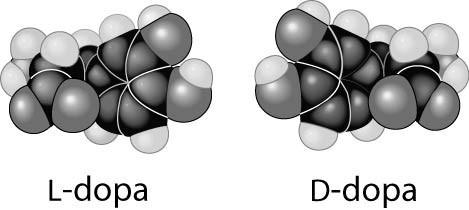 38) Thalidomide and L-dopa, shown below, are examples of pharmaceutical drugs that occur as enantiomers, or molecules that
Answer: Topic: Concept 4.2 Skill: Knowledge/Comprehension | back 38 B |
front 39 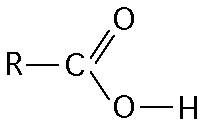 39) What is the name of the functional group shown in the figure above?
Answer: Topic: Concept 4.3 Skill: Knowledge/Comprehension | back 39 D |
front 40 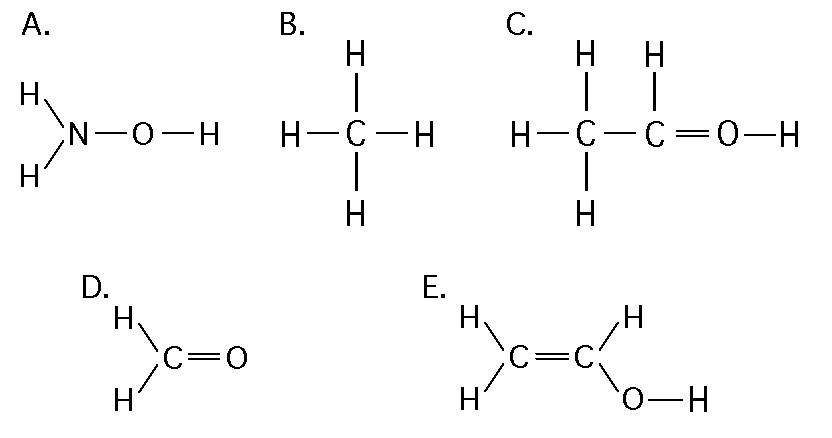 40) Which of the structures illustrated above is an impossible covalently bonded molecule?
Answer: Topic: Concept 4.3 Skill: Knowledge/Comprehension | back 40 C |
front 41 41) Which of the structures illustrated above contain(s) a carbonyl functional group?
Answer: Topic: Concept 4.3 Skill: Knowledge/Comprehension | back 41 D |
front 42 42) In which of the structures illustrated above are the atoms bonded by ionic bonds?
Answer: Topic: Concept 4.3 Skill: Knowledge/Comprehension | back 42 E |
front 43 43) Which of the structures illustrated above cannot form hydrogen bonds with water molecules?
Answer: Topic: Concept 4.3 Skill: Application/Analysis | back 43 B |
front 44 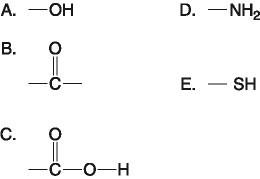 44) Which functional group shown above is characteristic of alcohols?
Answer: Topic: Concept 4.3 Skill: Knowledge/Comprehension | back 44 A |
front 45 45) Which functional group(s) shown above is (are) present in all amino acids?
Answer: Topic: Concept 4.3 Skill: Knowledge/Comprehension | back 45 E |
front 46 46) Which of the groups shown above is a carbonyl functional group?
Answer: Topic: Concept 4.3 Skill: Knowledge/Comprehension | back 46 B |
front 47 47) Which of the groups shown above is a functional group that helps stabilize proteins by forming covalent cross-links within or between protein molecules?
Answer: Topic: Concept 4.3 Skill: Knowledge/Comprehension | back 47 E |
front 48 48) Which of the groups above is a carboxyl functional group?
Answer: Topic: Concept 4.3 Skill: Knowledge/Comprehension | back 48 C |
front 49 49) Which of the groups above is an acidic functional group that can dissociate and release H+ into a solution?
Answer: Topic: Concept 4.3 Skill: Knowledge/Comprehension | back 49 C |
front 50 50) Which of the groups above is a basic functional group that can accept H+ and become positively charged?
Answer: Topic: Concept 4.3 Skill: Knowledge/Comprehension | back 50 D |
front 51 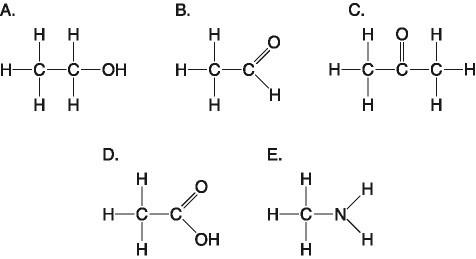 51) Which molecule shown above would have a positive charge in aqueous solution at pH 7?
Answer: Topic: Concept 4.3 Skill: Knowledge/Comprehension | back 51 E |
front 52 52) Which molecule(s) shown above is (are) ionized in aqueous solution at pH 7?
Answer: Topic: Concept 4.3 Skill: Application/Analysis | back 52 A |
front 53 53) Which molecules shown above contain a carbonyl group?
Answer: Topic: Concept 4.3 Skill: Knowledge/Comprehension | back 53 B |
front 54 54) Which molecule shown above has a carbonyl functional group in the form of a ketone?
Answer: Topic: Concept 4.3 Skill: Knowledge/Comprehension | back 54 C |
front 55 55) Which molecule shown above has a carbonyl functional group in the form of an aldehyde?
Answer: Topic: Concept 4.3 Skill: Knowledge/Comprehension | back 55 B |
front 56 56) Which molecule shown above contains a carboxyl group?
Answer: Topic: Concept 4.3 Skill: Knowledge/Comprehension | back 56 D |
front 57 57) Which molecule shown above can increase the concentration of hydrogen ions in a solution and is therefore an organic acid?
Answer: Topic: Concept 4.3 Skill: Knowledge/Comprehension | back 57 D |
front 58 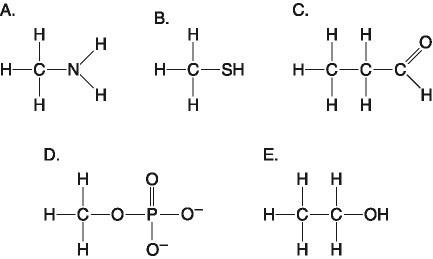 58) Which molecule shown above can form a dimer linked by a covalent bond?
Answer: Topic: Concept 4.3 Skill: Knowledge/Comprehension | back 58 B |
front 59 59) Which molecules shown above will form hydrogen bonds with water?
Answer: Topic: Concept 4.3 Skill: Application/Analysis | back 59 D |
front 60 60) Which molecule shown above contains an amino functional group, but is not an amino acid?
Answer: Topic: Concept 4.3 | back 60 A |
front 61 61) Which molecule shown above is a thiol?
Answer: Topic: Concept 4.3 Skill: Knowledge/Comprehension | back 61 B |
front 62 62) Which molecule shown above contains a functional group that cells use to transfer energy between organic molecules?
Answer: Topic: Concept 4.3 Skill: Application/Analysis | back 62 D |
front 63 63) Which molecule shown above can function as a base?
Answer: Topic: Concept 4.3 Skill: Knowledge/Comprehension | back 63 A |
front 64 64) A chemist wishes to make an organic molecule less acidic. Which of the following functional groups should be added to the molecule in order to do so?
Answer: Topic: Concept 4.3 Skill: Application/Analysis | back 64 D |
front 65 65) Organic chemistry is currently defined as
Answer: Topic: End-of-Chapter Questions Skill: Knowledge/Comprehension | back 65 B |
front 66 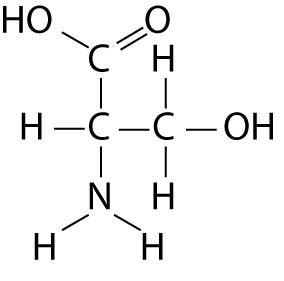 Which functional group is not present in this molecule?
Answer: Topic: End-of-Chapter Questions Skill: Knowledge/Comprehension | back 66 B |
front 67 67) Which chemical group is most likely to be responsible for an organic molecule behaving as a base?
Answer: Topic: End-of-Chapter Questions Skill: Knowledge/Comprehension | back 67 D |
front 68 68) Which of the following hydrocarbons has a double bond in its carbon skeleton?
Answer: Topic: End-of-Chapter Questions Skill: Application/Analysis | back 68 D |
front 69 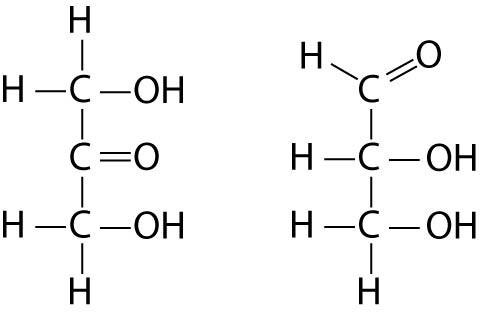 9) Choose the term that correctly describes the relationship between these two sugar molecules:
Answer: Topic: End-of-Chapter Questions Skill: Application/Analysis | back 69 A |
front 70 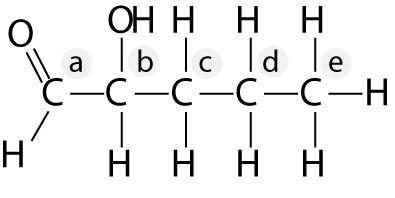 70) Identify the asymmetric carbon in this molecule.
Answer: Topic: End-of-Chapter Questions Skill: Application/Analysis | back 70 B |
front 71 71) Which action could produce a carbonyl group?
Answer: Topic: End-of-Chapter Questions Skill: Application/Analysis | back 71 A |